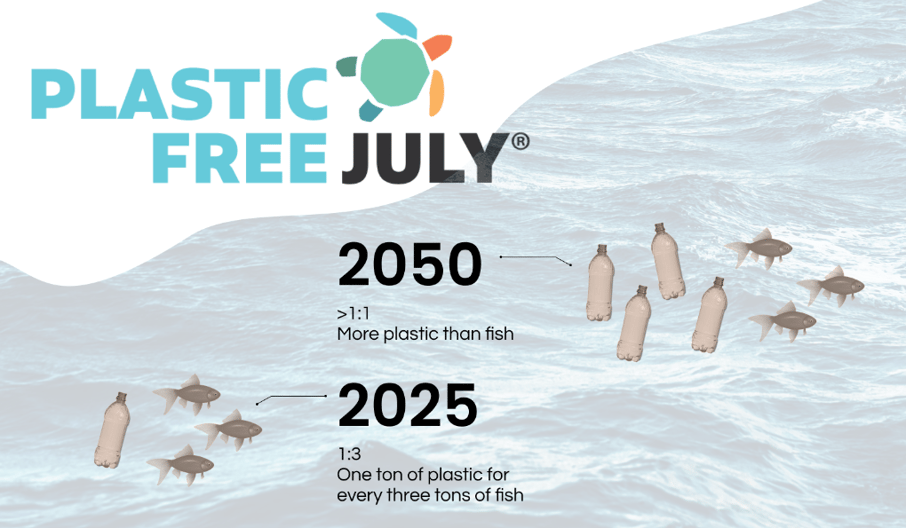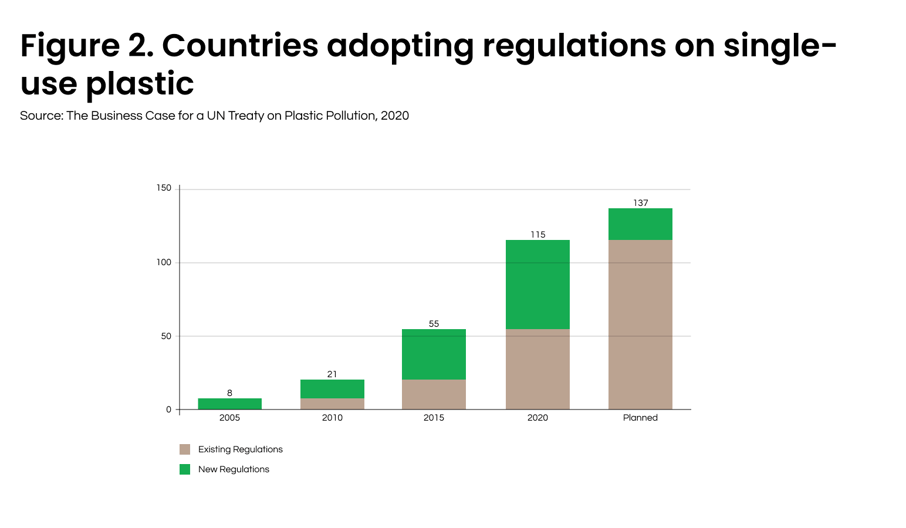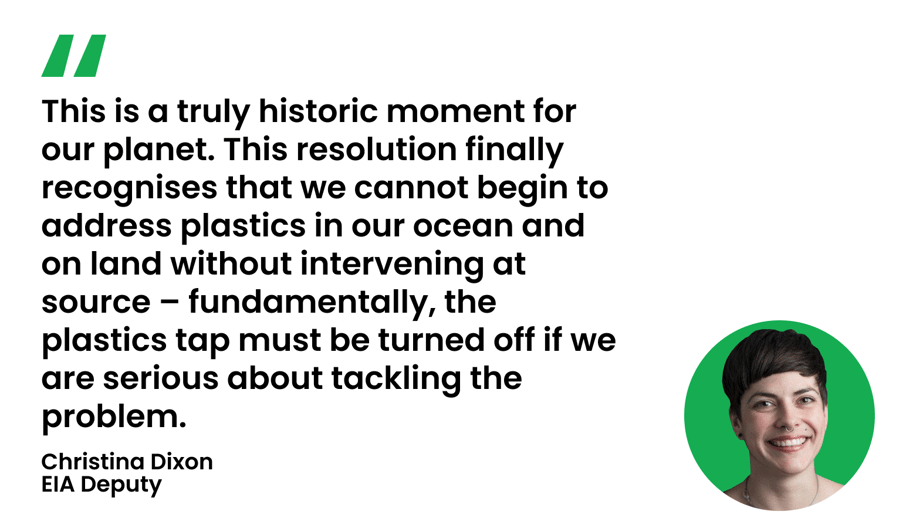We Have No Time to Waste (Plastic)
.png)
More plastic than fish
Plastic covers a substantial role in our everyday life. From storing lunch to bottling the fresh drink you crave during these long warm summer days, it's (almost) impossible not to use it.
As summer temperatures increase, single-use water bottle sales are also on the rise.
According to Plastic Oceans International, we produce over 380 million tons of plastic every year. Up to 50% of the total is meant for single-use products.
If you don't find these numbers impressive enough, you should know that the global human population has an average estimated weight of 316 million tons (LessPlastic, n.d.). We are outnumbered by the annual production of plastic, let alone the amount of plastic that currently exists.
Even more striking is that, according to OECD (2022), less than 10% of plastic used around the globe is recycled.
More than half of the plastic that has been produced is piling up in landfills or floating in our oceans. But this is something you might have heard or read before. A new fact might be that forecasts predict that by 2050, there will be more plastic than fish in our oceans.(Ellen MacArthur Foundation).

Additionally, as stated by Ellen MacArthur Foundation (2016), producing plastic and incinerating it for disposal generates approximately 400 million tonnes of CO2 every year.
To halt these trends, Plastic Free Foundation uses the month of July to challenge us to stay away from disposable plastic. The initiative started in 2011. Since then, it has involved individuals, businesses, governments, and communities.
In 2021, 140 million participants joined the challenge, avoiding:
- 301 million everyday plastic items;
- 2,1 million tonnes of waste.
In this article, we'll (as usual) focus specifically on an approach for organisations and suggest strategies to reduce or repurpose plastic waste from their operations.
But before diving into our recommendations, let's look at existing and upcoming regulations that will make plastic-free initiatives and programmes go beyond a challenge incentive.
Regulatory frameworks for a more circular economy
Within the 2030 Agenda, SDG 12 stresses the need to rethink the way we consume and produce.
To advance that, countries are rapidly introducing regulations on single-use plastic products. Over the past 5 years, the number of countries putting in place these regulations has more than doubled (The Business Case for a UN Treaty on Plastic Pollution, 2020).

Along with that, the European Commission has set the goal of achieving 100% recyclable plastic packaging by 2030.
As part of the Circular Economy Action Plan launched by the European Union, the EU Single-Use Plastic Directive came into force in July 2019.
The main implications of the Single-Use Plastic Directive are the followings:
Product bans
Certain single-use plastic products, for which a non-plastic alternative is available, have been banned (i.e. plastic bags, cotton bud sticks).Design requirements
Plastic bottle recycling collection target
Extended Producer Responsibility (EPR) Schemes
Awareness-raising measures
This past March the United Nations Environment Assembly (UNEA) agreed on the development of a global plastic pollution treaty. This would be the first binding agreement adopting a full life cycle approach.

The upcoming global treaty is expected to include:
- Common regulatory standards;
- Clear national targets and action plans to achieve the treaty’s goal;
- Common reporting standards across the plastic value chain;
- Support for research and innovation.
Towards a plastic-free future
As stated above, plastic pollution cannot be solved just by guiding the consumer in waste sorting through packaging labels.
We need bold and swift action to tackle the problem at the source, by edging organisations towards new ways of producing and selling products.
Within the EU, the Circular Economy Action Plan offers a valid framework to contribute to a greener economy. Below are the key pillars of the plan that can help organisation accelerate their plastic-free transition.
Rethink the design of your product
As 80% of a product’s environmental impacts are determined at the design phase (European Commission, 2014), it is pivotal to think circular right away.
Some sustainability features worth considering to reduce the impacts of your (plastic) products can be:
- Improve durability and reparability – Invest in Research & Development to source better performing materials and offer repair services to customers to extend the life of your products.
- Increase the recycled component of your products – Also given the upcoming mandatory thresholds set by the Single-Use Plastic Directive.
- Include modularity principles into your products – Modularity makes it easier to extend the life of your product by easing the repair process.
- Improve recyclability – As plastic is made of a variety of molecular chains (polymers) depending on the use, it is difficult to recycle. Additional materials such as adhesives and coatings make it even more complex to recycle plastic products. The advice to improve recyclability consists of simplifying the composition of your products as much as possible and reducing the use of colourants, labels, and adhesives.
Close the loop with a circular production process
Traditional recycling is one of the pillars in the 4 R (Reduce, Reuse, Recycle, & Rethink) model of waste management. Nevertheless, it’s not enough to solve the problem of plastic pollution.
A valid option to effectively close the loop of your production process is chemical recycling. This method breaks down plastic into its basic building blocks, making it possible to reuse them from scratch. Through chemical recycling, what we now consider waste can be turned into new raw material for businesses’ production processes.
Develop a waste policy
The design process should ease consumers in the disposal-sorting process by simplifying products and making them easier to recycle.
Especially considering the new EPR Schemes, plastic manufacturers are responsible for the collection and recycling of the plastic they produce beyond factory gates.
After all, companies themselves could benefit from improved after-use collection of products. These initiatives come with a switch from the ‘waste-oriented’ mindset to a ‘resource-oriented’ mindset.
Invest in research, innovation, and collaboration
Resources for Research & Innovation must be allocated to source for alternatives to plastic and ways to design products more sustainably. Next to private investments for circular innovations, the EU finances circularity through The European Regional Development Fund, LIFE, and Horizon Europe.
Additionally, collaboration is key to overcoming the challenges when looking for a closed-loop production process.
Suppliers and customers must be involved to help you achieve the goal of circularity. Additionally, you can rely on collaboration outside of your value chain with the goal of repurposing scraps or waste that does not fit into your processes anymore.
Conclusion
A plastic-free future is on the horizon regardless. Therefore, why not stay ahead of the game and start exploring plastic reduction opportunities before they become mandatory?
You can start today by joining the Plastic Free July Challenge, and then keep it up beyond it!